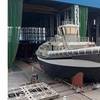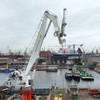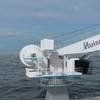The Virginia Pilot Boat Corporation has ordered a Chesapeake Class MKII launch from Gladding-Hearn Shipbuilding. The MKII, a new generation of the shipyard’s popular, smaller class of pilot boats, is the Virginia pilots’ eighth Gladding-Hearn pilot boat. Delivery is scheduled for 2018.
Since the Chesapeake Class pilot boat was introduced by the Somerset, Mass., shipyard in 2003, 17 have been delivered to pilot associations throughout the U.S. The latest improvements incorporate the performance benefits of Volvo Penta’s IPS 3 pod system, which provides for higher speed, lower fuel consumption, and more comfort, explained Peter Duclos, the shipyard’s president.
With a deep-V hull designed by C. Raymond Hunt & Associates, the all-aluminum pilot boat measures 55.10 feet overall, with a 17.2-foot beam and a 4.11-foot draft. It will be powered by twin Volvo Penta D13-700, EPA Tier 3-certified diesel engines, each producing 700 Bhp at 2250 rpm. Each engine is connected to a Volvo Penta IPS propulsion pod, fitted with dual forward-facing, counter-rotating propellers and integrated exhaust system, and Volvo Penta’s integrated EPS electronic steering and control system.
The EPS control system and three-axis joystick will increase the boat’s overall maneuverability alongside a ship and when docking, said Duclos.
The financial incentive for pilots to optimize fuel economy, vessel handling and comfort has led the shipyard to install a Humphree Interceptor automatic trim-optimization system on the MKII launch. “The combination of the Volvo Penta IPS system and the Humphree interceptors gives the pilots faster acceleration and higher speeds and improved comfort, while burning 25 percent less fuel than similar Chesapeake Class launches,” said Duclos. The boat will also be equipped with Humphree’s Coordinated Turn Optimization System, which will be integrated with the pod drives. The vessel’s top speed is expected to reach 32 knots.
An Alaska Diesel generator, with 12kW of output, will provide electricity.
Key design changes to the Chesapeake Class include positioning the wheelhouse aft of amidships to improve comfort and provide for a larger foredeck. With the pods close-coupled to the engines, the engine room is located well aft of the wheelhouse with easy access to machinery through a deck hatch.
This new generation of pilot boats can also accept a gyro-stabilization system, designed to reduce vessel roll.
The wheelhouse is outfitted with five Llebroc reclining seats and will be cooled by two 16,000 Btu air-conditioning units. The forecastle, with a 12,000 Btu AC unit, is designed to include a settee berth, an enclosed head and small galley. Outside of the wheelhouse are heated side-decks and handrails, and boarding platforms on the roof and, port and starboard, on the foredeck. A control station is located at the transom, along with a winch-operated, rotating davit over a recessed platform for pilot rescue operations.















